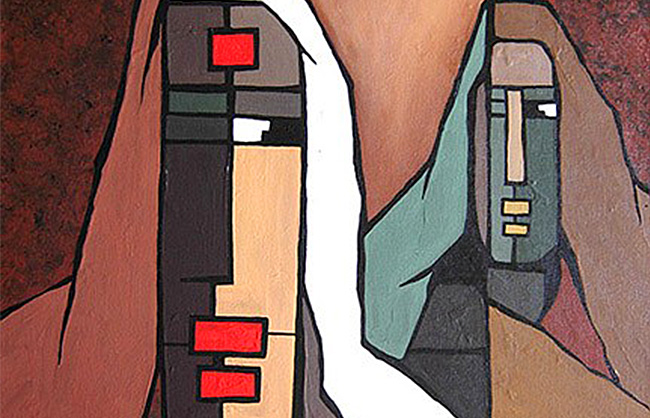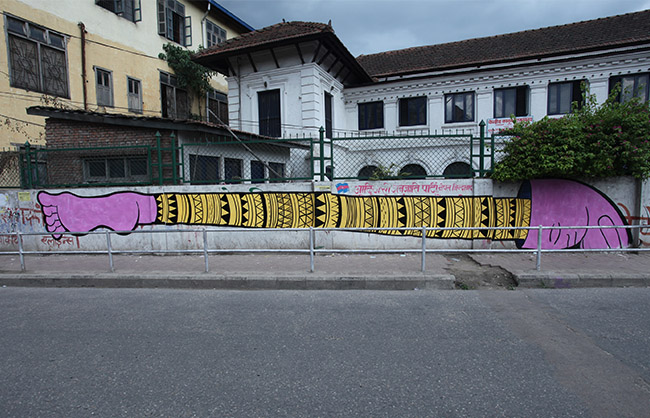Writing
Project Details
Title: Chasing the storm within
Category: Writing
Date: 24 November 2015
Share:
In the Eye of the Storm, a comprehensive read by Sangeeta Thapa, the curator of the Siddhartha Art Gallery at Babar Mahal Revisited, was recently launched in colligation with a display of Manuj Babu Mishra’s rare drawings and paintings at the Revisited gallery. While the exhibition, which shares the same title, concentrates more on Mishra’s years of self-imposed confinement, the book, published by Nepal Investment Bank, is more a monograph than a catalogue, and offers, in exhaustive detail, the entirety of Mishra’s extraordinary life, which spans nearly eight decades.
In recent years, Mishra is probably best known, at least in the art world, as an artist living in solitude, creating the impression of an introvert working within a set of strict limitations. It seems a miracle that such a vast array of paintings by this hermit, who has lived in self-imposed exile for the last two decades, is now on exhibit. All these years, a curiosity has gripped art lovers: what forced the artist to live beyond the reaches of the world? And even more, how has this gallery now managed to get hold of his rare work? Meanwhile, those who know the man by name alone question: what is it that makes his work stand out?
Mishra, 74, a former lecturer at the Lalit Kala Campus, decided to live in self-confinement in 1990, as Nepal metamorphosed politically from the Panchayat regime to a democracy. That self-incarceration, many speculate, was because of his ire at the changing political scenario, but little did anyone know at the time that this solitude would continue for decades and result in unparalleled riches for the Nepali art world. Now, no wall of the two floors of the gallery remains uncovered. From artworks which date back to the artist’s days in Dhaka as early back as 1962, to the much-talked-about self portraits, to the recent impressionist portrayals of the Nepali Monalisa; his work has truly traversed time.
“Mishra is among Nepal finest artists,” said eminent art writer and Director of the Indian Culture Centre, Dr. Geeti Sen. “He can draw beautifully detailed portraits, but sees himself in animalistic forms. Despite having travelled across the world, his works are still more personal than public and he has the awareness of a poet. But Mishra is not without humour.” The 51 paintings, done in a range of mediums ranging from pencil, lithograph, woodcut, to oil on canvas, illustrates the gradual psychological transformation of the artist. Mishra’s later works reflect time vividly, through his paintings of an apocalypse, exaggerated self-portraits, dramatised mythological characters, and even a few non-figuratives.
Over the years, what has remained highly disputed are his self-portraits, which some viewers see as self-possessed, self-indulgent, and egotistic. When questioned on the same, the artist replies with humour, “You or anyone would not like it if I drew a pair of horns or a tail on you, but with my own globe-like-head, I can draw all of my wildest imaginations.” The artist’s life and work seem to be a search for the inner self and exploration for an artist with both genius and the mind of an inquisitive child. Perhaps there is no other artist in Nepal who knows the self as much as Manuj Babu Mishra.
Despite his self-imposed isolation, the external world saw him rapidly become the most discussed self-portraitist in Kathmandu, and his friendship with art collector Prithivi Pandey and curator Sangeeta Thapa has allowed Kathmandu art lovers a rare peek into his works. Marking a successful exhibition and writing of the book, curator Thapa says “Manuj Babu’s drawings provide an intimate and emotional record of a contemporary Nepali artist’s reflections on life, politics, and art in the 21st century. His drawings can therefore be viewed as the triumph of human ingenuity, individuality, experience, and creativity over the forces of darkness, even as the artist, on our behalf, wades through the muck. Above all, Mishra’s drawings force us to confront our dark side so viscerally, that the wish that mankind had the ability to vanquish all evil, arises in us spontaneously.”
In spite of his claims to be an atheist, Mishra’s paintings tend to embody gods and demons alike and while one follows his works through the ages, these characters of myth tend to become more and more violent, and in some cases, extremely scandalous. “I am not religious in the manner most people are. I do not visit temples to worship idols, but am more attracted to them as artefact. How can you move forward if a mythological character from the past blocks your way? I prefer to keep them at the back of my head, not in front of my vision,” says Mishra. And his works affirm his words. Trishuls (Tridents) and missiles painted in monochromes, with pigmented watercolour and subdued patches symbolising the physical and metaphysical forces respectively. There is a neat balance between the exoteric and esoteric, the worldly and the poetically narcissistic. The artist’s self portraits in mixed media are distinctively masculine which is striking when compared to the over-sold feminism of other artists.
The first floor of the gallery showcases Mishra’s earlier works with damp shades, moist hues, monochromatic landscapes and magnificently detailed pencil sketches. As one climbs up the wooden staircase and into the second floor, one confronts a mixed media self-portrait with a face scrubbed with damp shade of blue and red merging with smoky black tones. The mouth of one of the faces touches the tip of the aroused lingam of the god Shiva. With elf-like ears and oversized eyes, the face of the artist stuns viewers. A skull dangles from his left earlobe while a missile hangs from the right. A devastated city of skyscrapers and a village with people revolting at the base further exemplify the clash between the physical and the metaphysical forces. The artist’s search for the animal in the self continues in his bamboo scribbles in the form of line art. Mishra sets up a dialogue between negative and positive spaces within the boundaries of his canvasses. The artist’s self-awareness and indulgence typify the works and yet, they manage to surprise the viewers with the emotional realism lurking behind the naive dramas.
Manuj Babu’s works are reflections on time with forceful personal and political mythology. He scribbles his name and personal history like a list of murder victims in ink. The ruthful wide-open eye gives way to turmoil of Abstract-Expressionist strokes and long slashes of primal hues. Abuse and death-by-violence are expressed through violent gestures, motley materials and the predominance of black. Metaphorically, his paintings are nothing short of sublime symphony, but the stories they tell are far more intricate and explicit. Works like his force the viewer to confront the viability of the artist’s ambitious mix. The abstract expressionist heritage is very evident. His works are as acute as of any of his Western contemporaries. Behind his heroic efforts, one senses a struggle to overcome the difficulties of being and creation. Through the portrayal of his personal struggle, Mishra attempts to disguise his political disgust, which may be one of the more genuine issue here. Mishra stands in solitude in his works, sometimes with deities and evils, but often as an evil in a deity.
Viewers are equally drawn by his paintings of the Nepali Monalisa. His originality lies in small surprises, in odd colour choices, and in slight shifts in texture. The paintings reveal a youthful artist in love with the task of finding and refining a comprehensive and abstract personal language. So what is it with the eye-browed Monalisa Kanchi in Sari and Mishra? The artist says with unmasked glee, “All these years I painted what I liked, or what I felt good about, but since I inked my first Monalisa, I realised, I have been in love with Monalisa all along.” The turmoil of expressionist strokes is sure to continue for ages, for it seems the artist has finally found love.
In the Eye of the Storm will was on display at the Siddhartha Art Gallery at Babar Mahal Revisited till Jan. 21.








